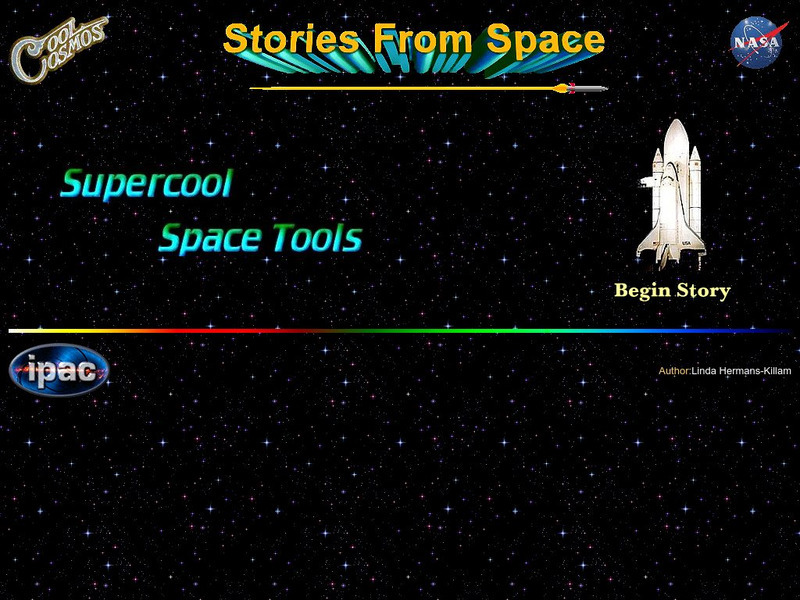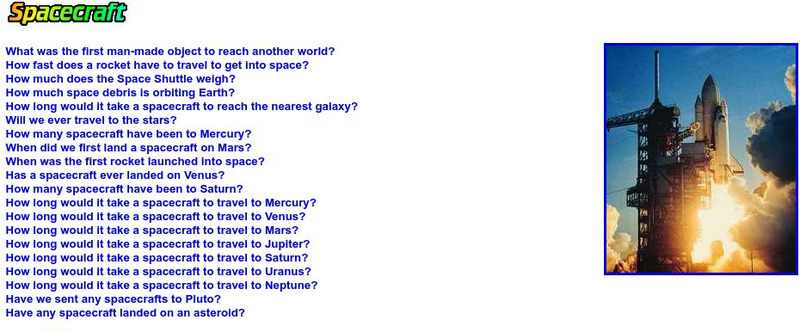Hi, what do you want to do?
Orpheus Books
Q Files: Technology: Space Transport
The story of space exploration is told from the first successful rocket built in 1926 to space probes and the International Space Station.
CK-12 Foundation
Ck 12: Earth Science: Satellites, Shuttles, and Space Stations Study Guide
[Free Registration/Login may be required to access all resource tools.] This study guide provides a brief overview of satellites, shuttles, rockets, and space stations. Includes a few questions to check for understanding.
NASA
NASA Kids Club: Rocket Builder
Students can hone their shape-recognition skills and use the plans to build a fleet of rockets.
TeachEngineering
Teach Engineering: Destination Outer Space
Students acquire a basic understanding of the science and engineering of space travel as well as a brief history of space exploration. They learn about the scientists and engineers who made space travel possible and briefly examine some...
Cosmos 4 kids
Cosmos4 Kids: Exploration: Rockets
The entire history of rocketry took place in 100 years! The early 1900's saw their first appearance, and by the end of the century, rocket technology took many forms with the most famous being the Space Shuttle. The brief, to the point...
California Institute of Technology
Stories From Space: Supercool Space Tools
A great story highlighting the history of space discovery and the tools then and now. Learn about the tools and technology that help us in our quest to go beyond our planet and our solar system.
TED Talks
Ted: Ted Ed: Will Future Spacecraft Fit in Our Pockets?
When you picture a rocket, you might imagine a giant ship carrying lots of fuel, people and supplies. But what if the next wave of spacecraft were small enough to fit into our pockets? Dhonam Pemba details the future of microspacecraft,...
Other
U.s. Space and Rocket Center: Space Camp
Join the fun at the Alabama space camp everyone is talking about. Watch behind-the-scenes clips, learn about the program offerings, and register for a week of space adventures. Link to the different levels of camps including Space Camp...
TeachEngineering
Teach Engineering: Rockets
This unit teaches students how and why engineers design satellites to benefit life on Earth as well as allows students an opportunity to explore motion, rockets and rocket motion. Students discover that the motion of all objects...
PBS
Pbs Teachers: The Hunt for Nazi Scientists: Von Braun's Rockets
Learn about the life and accomplishments of Wernher Von Braun and other Nazi space scientists through this interactive timeline. Discover how he came to the United States in Operation Paperclip and why he is known as the father of the...
TeachEngineering
Teach Engineering: Rocket Power
By making and testing simple balloon rockets, students acquire a basic understanding of Newton's third law of motion as it applies to rockets. Using balloons, string, straws and tape, they see how rockets are propelled by expelling...
Other
Virginia Space Flight Academy: Summer Residence Camps
Watch campers count down for take-off and the ultimate rocket launch during this summer space camp experience. Read about programs offered including spaceships, aerodynamics, microgravity, robotics, rocket assembly and launching,...
TeachEngineering
Teach Engineering: Into Space!
While building and testing model rockets fueled by antacid tablets, students are introduced to the basic physics concepts on how rockets work. Students revise and improve their initial designs. Note: This activity is similar to the...
NASA
Nasa: Engineering Design Challenges: Spacecraft Structures Educator Guide
This detailed educator's guide provides a lesson in designing the structure of a spacecraft. The design challenge contains pre-lab activities and instructions for how to test the models.
Reading Rockets
Reading Rockets: Reading Basics: Print Awareness
Print awareness is understanding that print is organized in a particular way - for example, knowing that print is read from left to right and top to bottom. It is knowing that words consist of letters and that spaces appear between...
California Institute of Technology
Cool Cosmos: Ask an Astronomer for Kids! Spacecraft
Cool Cosmos makes it easy to learn more about spacecrafts through an easy to use list of kid's frequently asked questions. Just click on the question to enhance your understanding of this modern technological wonder.
NASA
Nasa: Space Shuttle Basics
Basics of space shuttle operations are explained, including details of launch vehicle and orbiter configuration. Information on each shuttle Enterprise, Columbia, Challenger, Discovery, Atlantis, Endeavour is included. Has video and...
Smithsonian Institution
National Air and Space Museum: Milestones of Flight
This Smithsonian National Air and Space Museum site tells the history of fight with an easy to use timeline. Also, find out about specific flights in the list of links.
NASA
Nasa: John F. Kennedy Space Center (Ksc)
This exciting site provides a wealth of shuttle information, tours and exhibits at the center, and historical information.
Science Buddies
Science Buddies: Teaching the Scientific Method With Paper Rockets
This lesson will introduce your learners to the scientific method using a fun, hands-on activity.
Wikimedia
Wikipedia: Rocket
Wikipedia provides an encyclopedia definition of a rocket, including information on rocket history, size, types, and more.
NASA
Nasa: The Space Place: Build a Bubble Powered Rocket
This site from the National Aeronautics and Space Administration provides fun information on bubble powered rockets. "Build your own rocket using paper and fizzing tablets! Watch it lift off. How high does your rocket go?"
Wonderville Media
Wonderville: The Space Shuttle
Before the Space Shuttle was invented, NASA, which stands for the National Aeronautics and Space Administration, used rockets to get people to space. The problem with rockets is that they can only be used one time. They wanted a better...
TED Talks
Ted: Ted Ed: The Incredible Collaboration Behind the International Space Station
The International Space Station is roughly the size of a six-bedroom house and weighs more than 320 cars- it's so large that no single rocket could have lifted it into orbit. Instead, it was assembled piece by piece while hurtling...























